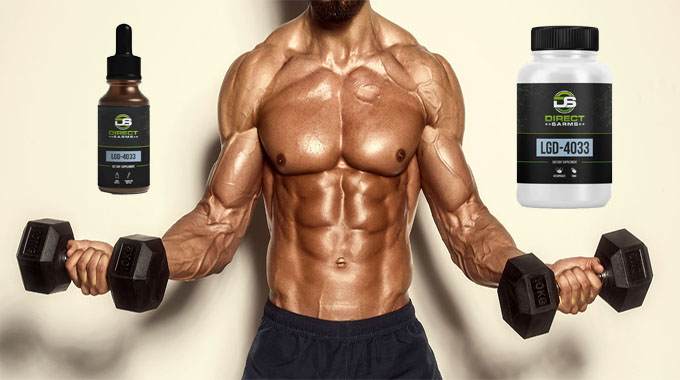Amplifier chemicals that bound to specific proteins are referred to as selective androgen receptor modulators, or SARMs for short. They were investigated as possible therapies for a variety of diseases and conditions, including cancer, osteoporosis, sexual dysfunction, myasthenia gravis, Stroke, and muscle wasting. SARMs have recently been included to a variety of supplements that are sold at those who are interested in fitness. It has been discovered that SARMs lower levels of endogenous testosterone, impact cholesterol levels, and change the function of the liver.
SARMs are often used in tandem with one another and on a cyclical basis by those who use them for recreational purposes. In addition to this, they may engage in postcycle treatment, which entails the use of SERMs in the downtime between cycles with the goal of reestablishing a healthy hormone balance. Pharmacists need to be aware of the harmful consequences that might come from using SARMs in order to properly counsel patients about the dangers that may be involved.
Pharmacists, who serve as an essential connection between patients and healthcare professionals, are expected to be aware of the possibility that patients may not always offer accurate information regarding the substances they take. One example of this would be selective androgen receptor modulators (SARMs), which are gaining popularity as performance-enhancing supplements owing to the fact that they have the ability to eliminate body fat, grow lean muscle mass, increase endurance, and speed up the recovery process.
Fitness enthusiasts, bodybuilders, and individuals whose occupations require them to be physically active are examples of the kind of people who could contemplate or actually partake in the recreational use of items containing SARMs. The World Anti-Doping Agency issued a ban on the use of SARMs in sports in the year 2008. In 2017, the Food and Drug Administration (FDA) issued a public advisory that stated that SARMs were being included in bodybuilding products and that these additives posed a greater risk of heart attacks, stroke, and damage to the liver. The advisory also stated that SARMs were being included in bodybuilding products. Buy Sarms LGD4033
The Council for Responsible Nutrition, which is the trade organisation for the industry of dietary supplements, issued a set of voluntary guidelines in response to the public warning that the FDA issued regarding SARMs. These guidelines encouraged that SARMs should not be included in any dietary supplements. SARMs may artificially lower intrinsic testosterone and have bad consequences on liver function and cholesterol levels, according to a warning issued by the Department of Defense’s (DOD) “Operation Supplement Safety.” This warning was issued to members of the armed services, healthcare professionals, and DOD civilians.
In a recent investigation, the chemical identities of the chemicals in dietary supplements and other items that are promoted and sold over the Internet as SARMs were determined, and the levels of those substances were measured, and then compared to the product labels for those products.
Only 52 percent of the 44 goods that were promoted and sold as SARMs were found to really contain one or more SARMs when they were analysed. An extra unauthorised medicine was found in 39% of the items, making the total number of unapproved drugs used. In nine percent of the items, there was no active component found, and twenty-five percent of the goods had compounds that were not specified on the label.
In only 41% of the goods did the amount of the active chemical in the product match that which was indicated on the label, and the amount of the compounds mentioned on the label was significantly different from that which was detected by analysis in 59% of the items. These findings bring to light an alarming lack of regulatory supervision and raise substantial questions about the goods’ level of safety.
Andarine (MK-2866), Ligandrol (LGD-4033), Testolone (RAD-140), and Ostarine (MK-2866) are the selective androgen receptor modulators (SARMs) that are now selling the best (GTx-007, S-4).
There have been very few clinical studies conducted to understand the pharmacokinetic profiles of SARMs, as well as to identify potential adverse effects and drug interactions. This is despite the fact that SARMs are becoming increasingly popular in the fitness and bodybuilding communities, and that their safety is supposedly not in question.
As a direct result of this, the majority of their potential long-term consequences on the body are yet unclear. The majority of clinical experience with SARMs comes from their usage in illegal activities rather than from clinical investigations.
In addition, the dosages and durations of SARM use that are common in the fitness community are far greater than what has been demonstrated to be safe and effective in scientific trials. It is not known how SARMs interact with other substances, such as alcohol and other narcotics, particularly when they are taken in large dosages or when they are used over an extended period of time.
SARMs that are sold under the guise of research chemicals can now be bought and sold legally, and this type of transaction frequently takes place on the internet. On the other hand, it is against the law to acquire or sell those that are sold in capsules intended for human consumption and/or are branded as nutritional supplements. In addition, they are not allowed to be sold to the general public as dietary supplements, nor may claims be made about the advantages that they provide. In this article, we conduct a literature analysis of the most recent clinical studies to analyse the potential positive and negative effects of utilising SARMs as performance enhancers on one’s health.
Alternatives to androgenic and competitive steroids are known as nonsteroidal SARMs.
Substances are a class of performance-enhancing agents that were discovered in the late 1990s. These agents promote anabolism, which means they enhance muscle growth and strength while also facilitating recovery after exercise.
SARMs are not androgenic steroids; rather, they are synthetic molecules that bind to endogenous testosterone. SARMs have been shown to provide a variety of health benefits (ARs). They can act as either full agonists or partial agonists, or even as antagonists, depending on the chemical structure they possess.
Each SARM-AR complex has its own unique shape, and different tissues (such as skeletal muscle, bone, the prostate, the brain, the skin, and the liver) each have their own distinct pattern of AR expression.
SARMs are able to increase physiological activity in a tissue-selective way via mediating coregulators and transcription factors or signalling cascade proteins. This is how they accomplish this. Because they are nonsteroidal and have less side effects than anabolic androgenic steroids, selective androgen receptor modulators (SARMs) are an appealing option. Direct SARMS
In contrast to steroidal androgen preparations, selective androgen receptor modulators (SARMs) have a high bioavailability when taken orally. Nonsteroidal selective androgen receptor modulators (SARMs) have been shown to have reduced androgenic action. This is because alpha-reductase, an enzyme that is widely expressed in androgenic tissues, is unable to convert nonsteroidal SARMs to the androgen dihydrotestosterone (DHT).
Aromatase is unable to convert them to oestrogen throughout the metabolic process. It has been determined that nonsteroidal SARMs have advantages over their steroidal counterparts when all of these characteristics are taken into consideration. In point of fact, selective androgen receptor modulators (SARMs) have demonstrated significant restorative promise for a variety of medical conditions, including male contraception, bone loss, prostate cancer, loss of libido, benign prostatic hyperplasia, Alzheimer’s disease, down’s syndrome, prostate cancer, and the muscle loss attributed with cachexia and bone disorders. Recreational users are increasingly using the diverse anabolic characteristics of different SARMs to selectively attain outcomes in terms of “bulking” and “cutting.” This trend is at least partially fuelled by the assumption that SARMs are milder than steroid. The term “cutting” refers to a phase of a weight loss programme that combines strict adherence to a weight loss diet with aerobic exercise and weight training of a lower intensity.
The term “bulking” refers to a phase of a weight loss programme that combines intense weight training with a diet designed to promote weight gain. According to anecdotal evidence, various SARMs provide varying outcomes in terms of bulking vs cutting, which is why bodybuilders and other fitness enthusiasts regularly use them in tandem with each other (also known as stacking).
Ostarine/Enobosarm/GTx-024/MK-2866/S-22
Ostarine is a nonsteroidal selective androgen receptor modulator (SARM) that may be taken orally and is bioavailable. It was created by Gtx, Inc. in the late 1990s with the primary intention of treating osteoporosis and muscle wasting. Ostarine is the SARM that has been studied and described in the clinic the most. In the limited clinical trials that have been published, it has been investigated as to whether or not it may be used to treat the skeletal muscle deficiencies that are associated with stress urine incontinence, breast cancer, non-small-cell lung cancer, and cachexia caused by cancer.
A considerable increase in total lean body mass was routinely found in the clinical trials that have been carried out up to this point, even in cancer patients. There was an associated drop in total fat mass, but there was no difference in total body weight, according to the findings of several research. Headache, nausea, weariness, and back discomfort were common low-grade adverse effects that occurred often. Other effects that were identified were a temporary rise in alanine transaminase (ALT), decreases in high density lipoprotein (HDL), blood glucose, insulin, and insulin resistance, and an increase in insulin sensitivity. When therapy was stopped, all of these abnormal parameters reverted back to their normal values.
People who are interested in fitness and bodybuilding should take ostarine as a supplement in doses ranging from 10 mg to 30 mg for a minimum of 12 weeks, according to the information that is published on personal blogs and commercial websites. These dosages are ten times higher than what was investigated in clinical trials. There is some anecdotal data that shows that taking ostarine at this high doses for such a prolonged length of time might adversely result in reduced testosterone levels. Reduced sex drive, erectile dysfunction, infertility, loss of bone density, muscle weakness, weight gain accompanied by increased body fat, insomnia, and depression are some of the side effects that can occur when testosterone levels drop.
Other side effects include decreased sex drive in women and infertility in men. There is scant evidence of medication interactions that are clinically significant between ostarine (including its primary metabolite) and itraconazole, probenecid, celecoxib, or rosuvastatin, despite the fact that these potential drug-drug interactions have been investigated. 19 One website that promotes SARMs suggests that SARMs be “stacked” for increased and differentiated effects. This is in accordance with the recommendation made on that website. 13 It is still uncertain whether or not taking increased dosages of numerous SARMs on a consistent basis puts one at risk for negative drug-drug interactions.
Ligandrol/LGD-4033/VK5211
Another SARM that may be taken orally and is bioavailable is ligndrol. The medicine was created by Ligand Pharmaceuticals, and to far, there has only been one clinical trial employing it. 20 76 healthy males were randomly assigned to receive either a placebo or 0.1 mg, 0.3 mg, or 1.0 mg of LGD-4033 once daily for a period of three weeks in the trial that was controlled by a placebo. The medicine was well tolerated, and there were no significant adverse drug events that occurred. At either dosage, there was no change in haemoglobin, prostate-specific antigen, aspartate aminotransferase (AST), alanine aminotransferase (ALT), or QT intervals. There was no change in luteinizing hormone levels despite the considerable suppression of follicle-stimulating hormone and free testosterone that occurred at the 1.0 mg dosage.
After stopping the medication, hormone levels recovered to their previous, healthy levels. There was no statistically significant change in either the amount of fat or the amount of appendicular skeletal muscle mass, but there was a dose-dependent increase in lean body mass. Although there was a tendency toward a dose-dependent gain in strength as well as stair-climbing speed and power, the results were not statistically significant. At either dose, neither total cholesterol nor low-density lipoprotein (LDL) cholesterol exhibited a significant change from baseline levels. The HDL level reverted to normal once treatment was stopped, despite the fact that it had increased at the 0.3 and 1.0 mg dosages. All dosages resulted in a reduction in triglyceride levels compared to baseline. The most prevalent adverse effects were complaints of headache and dry mouth.
A guy who was otherwise healthy and 24 years old was described in a recent case report as showing symptoms of hepatocellular liver damage. These symptoms began to appear one week after the last dose of medication was taken. The individual had a history of drinking excessively in one sitting, did not use any drugs on a regular basis, and did not have a history of liver illness. This hepatotoxicity is a part of the spectrum of liver damage that is associated with androgenic anabolic steroids, which is cause for worry.
There are a lot of blogs on the internet that talk about how beneficial Ligandrol is for improving performance, bulking up (as opposed to cutting), muscle hardening, boosting vascularity, becoming bigger, and improving recovery.
It is recommended that those interested in improving their fitness take between 5 mg and 10 mg on a daily basis for a period of 6 to 10 weeks, with the caveat that there is a potential for testosterone suppression at dosages higher than 10 mg. Ligandrol, much like ostarine, is frequently combined with several other SARMs in order to get optimal results. Nausea, exhaustion, headaches, and a decreased libido are some of the anecdotal adverse effects that have been documented in the fitness and bodybuilding communities. These symptoms may all be linked to lower testosterone levels.
Testolone/RAD-140
Testolone is a selective androgen receptor modulator (SARM) that is most commonly utilised in the treatment of breast cancer and muscle atrophy. Testolone, which was developed by Radius Health, Inc., is apparently still in the initial stage of clinical testing, and the findings are anticipated to be released later on in this year. As a result, there is currently very little information available on its safety. One recent case report, on the other hand, describes substantial liver damage in a guy who was 49 years old and had used the medication (dose not reported).
A mixed hepatocellular and cholestatic liver damage was suggested by elevated levels of bilirubin, AST, and ALT, as well as creatinine. Inflammation was also detected by the liver histology. However, after a period of 12 months following his original presentation, all of his liver tests had returned to normal. Anecdotally, users of SARMs suggested that Testolone be taken at doses ranging from 5 mg to 30 mg per day for a period of 8 to 16 weeks in order to acquire lean muscle mass and strength in the gym. There is more evidence in the form of anecdotes that point to adverse effects such as inability to sleep and tiredness.














